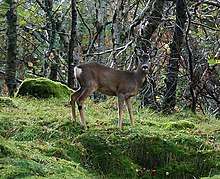List of mammals of Poland
This list shows the IUCN Red List status of the 112 mammal species occurring in Poland which have been recorded in historic times. Of these, two are endangered, three are vulnerable, and five are near threatened. Three of the species listed for Poland are nationally extinct. The following tags are used to highlight each species' status as published by the International Union for Conservation of Nature:
| EX | Extinct | No reasonable doubt that the last individual has died. |
| EW | Extinct in the wild | Known only to survive in captivity or as a naturalized populations well outside its previous range. |
| CR | Critically endangered | The species is in imminent risk of extinction, as the wild population comprises less than 250 individuals. |
| EN | Endangered | The species is facing an extremely high risk of extinction, as the wild population comprises less than 2500 individuals. |
| VU | Vulnerable | The species is facing a high risk of extinction, as the wild population comprises less than 10000 individuals. |
| NT | Near threatened | The species does not meet any of the criteria that would categorise it as risking extinction but it is likely to do so in the future. |
| LC | Least concern | There are no current identifiable risks to the species. |
| DD | Data deficient | There is inadequate information to make an assessment of the risks to this species. |
- † = a species extinct in Poland and not reintroduced
- ♠ = a sporadic vagrant, no records of breeding in Poland
- ◊ = an alien species, introduced in Poland from elsewhere
Subclass: Theria
Infraclass: Eutheria
Order: Rodentia (rodents)
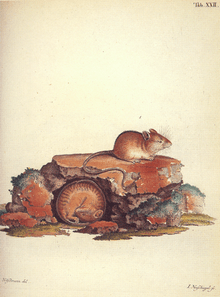
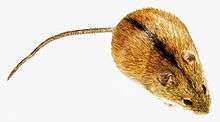
Rodents make up the largest order of mammals, with over 40% of mammalian species. They have two incisors in the upper and lower jaw which grow continually and must be kept short by gnawing.
- Suborder: Sciurognathi
- Family: Castoridae (beavers)
- Genus: Castor
- Eurasian beaver, C. fiber LC[1]
- American beaver, C. canadensis ◊ † LC
- Genus: Castor
- Family: Sciuridae (squirrels)
- Subfamily: Sciurinae
- Tribe: Sciurini
- Genus: Sciurus
- Red squirrel, S. vulgaris LC[2]
- Genus: Sciurus
- Tribe: Sciurini
- Subfamily: Xerinae
- Tribe: Marmotini
- Genus: Marmota
- Alpine marmot, Marmota marmota LC
- Genus: Spermophilus
- European ground squirrel, Spermophilus citellus VU
- Speckled ground squirrel, Spermophilus suslicus VU
- Genus: Marmota
- Tribe: Marmotini
- Subfamily: Sciurinae
- Family: Gliridae (dormice)
- Subfamily: Leithiinae
- Genus: Dryomys
- Forest dormouse, Dryomys nitedula LC
- Genus: Eliomys
- Garden dormouse, E. quercinus NT[3]
- Genus: Muscardinus
- Hazel dormouse, Muscardinus avellanarius
- Genus: Dryomys
- Subfamily: Glirinae
- Genus: Glis
- Edible dormouse, Glis glis LC
- Genus: Glis
- Subfamily: Leithiinae
- Family: Dipodidae (jerboas)
- Subfamily: Sicistinae
- Genus: Sicista
- Northern birch mouse, Sicista betulina LC
- Southern birch mouse, Sicista subtilis LC
- Genus: Sicista
- Subfamily: Sicistinae
- Family: Cricetidae
- Subfamily: Cricetinae
- Genus: Cricetus
- European hamster, Cricetus cricetus LC
- Genus: Cricetus
- Subfamily: Arvicolinae
- Genus: Ondatra
- Muskrat, Ondatra zibethicus ◊ LC
- Genus: Arvicola
- European water vole, A. amphibius LC[4]
- Genus: Chionomys
- Snow vole, Chionomys nivalis LC
- Genus: Clethrionomys
- Bank vole, Myodes glareolus LC
- Genus: Microtus
- Field vole, Microtus agrestis LC
- Common vole, Microtus arvalis LC
- Tundra vole, Microtus oeconomus LC
- European pine vole, Microtus subterraneus LC
- Tatra vole, Microtus tatricus NT
- Genus: Ondatra
- Subfamily: Cricetinae
- Family: Muridae (mice, rats, voles, gerbils, hamsters, etc.)
- Subfamily: Murinae
- Genus: Apodemus
- Striped field mouse, Apodemus agrarius LC
- Yellow-necked mouse, Apodemus flavicollis LC
- Wood mouse, Apodemus sylvaticus LC
- Ural field mouse, Apodemus uralensis LC
- Genus: Micromys
- Eurasian harvest mouse, Micromys minutus LC
- Genus: Mus
- House mouse, Mus musculus LC
- Genus: Rattus
- Genus: Apodemus
- Subfamily: Murinae
- Family: Castoridae (beavers)
Order: Lagomorpha (lagomorphs)
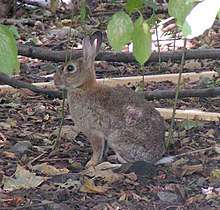
The lagomorphs comprise two families, Leporidae (hares and rabbits), and Ochotonidae (pikas). Though they can resemble rodents, and were classified as a superfamily in that order until the early twentieth century, they have since been considered a separate order. They differ from rodents in a number of physical characteristics, such as having four incisors in the upper jaw rather than two.
- Family: Leporidae (rabbits, hares)
- Genus: Lepus
- European hare, L. europaeus LC[6]
- Mountain hare, L. timidus LC
- Genus: Oryctolagus
- European rabbit, O. cuniculus introduced, EN in Iberian Peninsula[7]
- Genus: Lepus
Order: Erinaceomorpha (hedgehogs and gymnures)
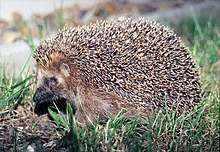
The order Erinaceomorpha contains a single family, Erinaceidae, which comprise the hedgehogs and gymnures. The hedgehogs are easily recognised by their spines while gymnures look more like large rats.
- Family: Erinaceidae (hedgehogs)
- Subfamily: Erinaceinae
- Genus: Erinaceus
- West European hedgehog, E. europaeus LC[8]
- Northern white-breasted hedgehog, E. roumanicus LC
- Genus: Erinaceus
- Subfamily: Erinaceinae
- Family: Erinaceidae (hedgehogs)
Order: Soricomorpha (shrews, moles, and solenodons)
The "shrew-forms" are insectivorous mammals. The shrews and solenodons closely resemble mice while the moles are stout-bodied burrowers.
- Family: Soricidae (shrews)
- Subfamily: Crocidurinae
- Genus: Crocidura
- Bicolored shrew, Crocidura leucodon LC
- Lesser white-toothed shrew, Crocidura suaveolens LC
- Genus: Crocidura
- Subfamily: Soricinae
- Tribe: Nectogalini
- Genus: Neomys
- Southern water shrew, Neomys anomalus LC
- Eurasian water shrew, Neomys fodiens LC
- Genus: Neomys
- Tribe: Soricini
- Genus: Sorex
- Alpine shrew, Sorex alpinus LC
- Common shrew, Sorex araneus LC
- Laxmann's shrew, Sorex caecutiens LC
- Eurasian pygmy shrew, Sorex minutus LC
- Genus: Sorex
- Tribe: Nectogalini
- Subfamily: Crocidurinae
- Family: Talpidae (moles)
- Subfamily: Talpinae
- Tribe: Talpini
- Genus: Talpa
- European mole, Talpa europaea LC
- Genus: Talpa
- Tribe: Talpini
- Subfamily: Talpinae
- Family: Soricidae (shrews)
Order: Chiroptera (bats)
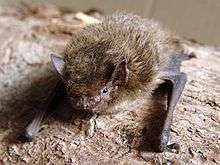
The bats' most distinguishing feature is that their forelimbs are developed as wings, making them the only mammals capable of flight. Bat species account for about 20% of all mammals.
- Family: Vespertilionidae
- Subfamily: Myotinae
- Genus: Myotis
- Bechstein's bat, M. bechsteini NT[9]
- Pond bat, M. dasycneme NT[10]
- Greater mouse-eared bat, M. myotis LC[11]
- Lesser mouse-eared bat, M. blythii LC[12]
- Brandt's bat, M. brandti LC
- Daubenton's bat, M. daubentonii LC
- Geoffroy's bat, M. emarginatus
- Whiskered bat, M. mystacinus LC
- Natterer's bat, M. nattereri LC
- Genus: Myotis
- Subfamily: Vespertilioninae
- Genus: Barbastella
- Barbastelle, B. barbastellus
- Genus: Eptesicus
- Northern bat, Eptesicus nilssonii LC
- Serotine bat, Eptesicus serotinus LC
- Genus: Nyctalus
- Lesser noctule, N. leisleri LC[13]
- Common noctule, N. noctula LC[14]
- Greater noctule bat, N. lasiopterus NT[15]
- Genus: Pipistrellus
- Nathusius' pipistrelle, P. nathusii LC[16]
- Common pipistrelle, P. pipistrellus LC
- Soprano pipistrelle, P. pygmaeus
- Kuhl's pipistrelle, P. kuhlii ♠ LC
- Genus: Plecotus
- Brown long-eared bat, Plecotus auritus LC
- Grey long-eared bat, Plecotus austriacus LC
- Genus: Vespertilio
- Parti-coloured bat, Vespertilio murinus LC
- Genus: Barbastella
- Subfamily: Myotinae
- Family: Rhinolophidae
- Subfamily: Rhinolophinae
- Genus: Rhinolophus
- Greater horseshoe bat, R. ferrumequinum ♠ LC
- Lesser horseshoe bat, R. hipposideros LC
- Genus: Rhinolophus
- Subfamily: Rhinolophinae
Order: Cetacea (whales)
The order Cetacea includes whales, dolphins and porpoises. They are the mammals most fully adapted to aquatic life with a spindle-shaped nearly hairless body, protected by a thick layer of blubber, and forelimbs and tail modified to provide propulsion underwater.
- Suborder: Mysticeti
- Family: Balaenidae (right whales)
- Genus: Balaena
- North Atlantic right whale, Eubalaena glacialis ♠ CR or functionally extinct in the eastern Atlantic
- Genus: Balaena
- Family: Eschrichtiidae (gray whales)
- Genus: Eschrichtius
- North Atlantic gray whale, Eschrichtius robustus ♠ EX [17]
- Genus: Eschrichtius
- Family: Balaenopteridae
- Subfamily: Balaenopterinae
- Genus: Balaenoptera
- Common minke whale, B. acutorostrata LC[18]
- Sei whale, B. borealis ♠ EN
- Fin whale, B. physalus ♠ EN
- Genus: Balaenoptera
- Subfamily: Megapterinae
- Genus: Megaptera
- Humpback whale, Megaptera novaeangliae ♠ LC
- Genus: Megaptera
- Subfamily: Balaenopterinae
- Family: Balaenidae (right whales)
- Suborder: Odontoceti
- Family: Phocoenidae
- Genus: Phocoena
- Harbour porpoise, Phocoena phocoena VU
- Genus: Phocoena
- Family: Monodontidae
- Genus: Delphinapterus
- Beluga, Delphinapterus leucas ♠ VU
- Genus: Delphinapterus
- Family: Ziphidae
- Genus: Mesoplodon
- Sowerby's beaked whale, Mesoplodon bidens ♠ DD
- Genus: Hyperoodon
- Northern bottlenose whale, Hyperoodon ampullatus ♠ LC
- Genus: Mesoplodon
- Family: Delphinidae (marine dolphins)
- Genus: Delphinus
- Short-beaked common dolphin, Delphinus delphis ♠ LC
- Genus: Lagenorhynchus
- White-beaked dolphin, Lagenorhynchus albirostris ♠ LC
- Genus: Tursiops
- Bottlenose dolphin, Tursiops truncatus ♠ DD
- Genus: Orcinus
- Genus: Delphinus
- Family: Phocoenidae
Order: Carnivora (carnivorans)
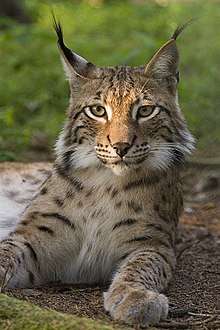
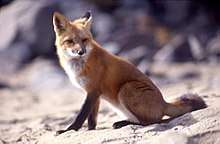
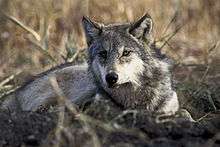
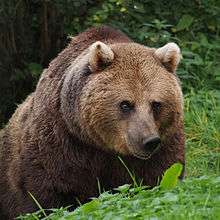
There are over 260 species of carnivorans, the majority of which feed primarily on meat. They have a characteristic skull shape and dentition.
- Suborder: Feliformia
- Family: Felidae (cats)
- Subfamily: Felinae
- Genus: Felis
- European wildcat, F. silvestris LC
- Genus: Lynx
- Eurasian lynx, L. lynx LC[20]
- Genus: Felis
- Subfamily: Felinae
- Family: Felidae (cats)
- Suborder: Caniformia
- Family: Canidae (dogs, foxes)
- Genus: Canis
- Gray wolf, C. lupus LC[21]
- Genus: Vulpes
- Genus: Nyctereutes
- Raccoon dog, Nyctereutes procyonoides ◊ LC
- Genus: Canis
- Family: Procyonidae (raccoons)
- Family: Ursidae (bears)
- Genus: Ursus
- Brown bear, U. arctos LC[23]
- Genus: Ursus
- Family: Mustelidae (mustelids)
- Genus: Mustela
- Stoat, M. erminea LC
- Steppe polecat, M. eversmannii LC
- European mink, M. lutreola† EN
- American mink, M. vison ◊ LC
- Least weasel, M. nivalis LC
- European polecat, M. putorius LC
- Genus: Martes
- Beech marten, M. foina LC[24]
- Pine marten, M. martes LC
- Genus: Meles
- Eurasian badger, M. meles LC[25]
- Genus: Lutra
- European otter, L. lutra NT[26]
- Genus: Mustela
- Family: Phocidae (earless seals)
- Genus: Halichoerus
- Grey seal, H. grypus LC
- Genus: Phoca
- Common seal, P. vitulina LC
- Genus: Pusa
- Ringed seal, P. hispida LC
- Genus: Halichoerus
- Family: Canidae (dogs, foxes)
Order: Perissodactyla (odd-toed ungulates)
The odd-toed ungulates are browsing and grazing mammals. They are usually large to very large, and have relatively simple stomachs and a large middle toe.
- Family: Equidae (horses etc.)
- Genus: Equus
- Wild horse, Equus ferus† EW
- Genus: Equus
Order: Artiodactyla (even-toed ungulates)
The even-toed ungulates are ungulates whose weight is borne about equally by the third and fourth toes, rather than mostly or entirely by the third as in perissodactyls. There are about 220 artiodactyl species, including many that are of great economic importance to humans.
- Family: Suidae (pigs)
- Family: Cervidae (deer)
- Subfamily: Capreolinae
- Family: Bovidae (cattle, antelope, sheep, goats)
See also
References
- Batbold, J.; Batsaikhan, N.; Shar, S.; Hutterer, R.; Kryštufek, B.; Yigit, N.; Mitsain, G.; Palomo, L. (2016). "Castor fiber". IUCN Red List of Threatened Species. 2016: e.T4007A115067136.
- Amori, G.; Hutterer, R.; Kryštufek, B.; Yigit, N.; Mitsain, G.; Muñoz, L. J. P. (2010). "Sciurus vulgaris". IUCN Red List of Threatened Species. 2010: e.T20025A9136220.
- Bertolino, S.; Amori, G.; Henttonen, H.; Zagorodnyuk, I.; Zima, J.; Juškaitis, R.; Meinig, H. & Kryštufek, B. (2008). "Eliomys quercinus". IUCN Red List of Threatened Species. 2008: e.T7618A12835766. doi:10.2305/IUCN.UK.2008.RLTS.T7618A12835766.en.
- Batsaikhan, N.; Henttonen, H.; Meinig, H.; Shenbrot, G., Bukhnikashvili, A., Hutterer, R., Kryštufek, B., Yigit, N., Mitsain, G. & Palomo, L. (2016). "Arvicola amphibius". IUCN Red List of Threatened Species. 2016: e.T2149A115060819. doi:10.2305/IUCN.UK.2016-3.RLTS.T2149A115060819.en.CS1 maint: multiple names: authors list (link)
- Kryštufek, B.; Palomo, L.J.; Hutterer, R.; Mitsain, G. & Yigit, N. (2015). "Rattus rattus". IUCN Red List of Threatened Species. 2015: e.T19360A115148682. doi:10.2305/IUCN.UK.2016-3.RLTS.T19360A15137085.en.{{cite iucn}}: error: |doi= / |page= mismatch (help)
- Hacklande, K.; Schai-Braun, S. (2019). "Lepus europaeus". IUCN Red List of Threatened Species. 2019: e.T41280A45187424. doi:10.2305/IUCN.UK.2019-1.RLTS.T41280A45187424.en.
- Villafuerte, R.; Delibes-Mateos, M. (2019). "Oryctolagus cuniculus". IUCN Red List of Threatened Species. 2019: e.T41291A45189779.
- Amori, G. (2016). "Erinaceus europaeus". IUCN Red List of Threatened Species. 2016: e.T29650A2791303. doi:10.2305/IUCN.UK.2016-3.RLTS.T29650A2791303.en.
- Paunović, M. (2019). "Myotis bechsteinii". IUCN Red List of Threatened Species. 2019: e.T14123A22053752. doi:10.2305/IUCN.UK.2016-2.RLTS.T14123A22053752.en.
- Piraccini, R. (2016). "Myotis dasycneme". IUCN Red List of Threatened Species. 2016: e.T14127A22055164. doi:10.2305/IUCN.UK.2016-2.RLTS.T14127A22055164.en.
- Coroiu, I.; Juste, J. & Paunović, M. (2016). "Myotis myotis". IUCN Red List of Threatened Species. 2016: e.T14133A22051759. doi:10.2305/IUCN.UK.2016-2.RLTS.T14133A22051759.en.CS1 maint: multiple names: authors list (link)
- Juste, J. & Paunović, M. (2016). "Myotis blythii". IUCN Red List of Threatened Species. 2016: e.T14124A22053297. doi:10.2305/IUCN.UK.2016-2.RLTS.T14124A22053297.en.CS1 maint: multiple names: authors list (link)
- Juste, J. & Paunović, M. (2016). "Nyctalus leisleri". IUCN Red List of Threatened Species. 2016: e.T14919A22016159. doi:10.2305/IUCN.UK.2016-2.RLTS.T14919A22016159.en.CS1 maint: multiple names: authors list (link){{cite iucn}}: error: malformed |page= identifier (help)
- Csorba, G. & Hutson, A.M. (2016). "Nyctalus noctula". IUCN Red List of Threatened Species. 2016: e.T14920A22015682. doi:10.2305/IUCN.UK.2016-2.RLTS.T14920A22015682.en.CS1 maint: multiple names: authors list (link)
- Hutson, A. M.; Alcaldé, J. T.; Juste, J.; Karataş, A.; Palmeirim, J. & Paunović, M. (2010). "Nyctalus lasiopterus". IUCN Red List of Threatened Species. 2010: e.T14918A4471682.CS1 maint: multiple names: authors list (link)
- Hutson, A. M.; Spitzenberger, F.; Juste, J.; Aulagnier, S.; Palmeirim, J.; Karatas, A. & Paunovic, M. (2010). "Pipistrellus nathusii". IUCN Red List of Threatened Species. 2010: e.T17316A6966886.CS1 maint: multiple names: authors list (link)
- Regional Species Extinctions - Examples of regional species extinctions over the last 1000 years and more. Archived 2015-09-24 at the Wayback Machine
- Cooke, J.G. (2018). "Balaenoptera acutorostrata". IUCN Red List of Threatened Species. 2018: e.T2474A50348265. doi:10.2305/IUCN.UK.2018-2.RLTS.T2474A50348265.en.
- Reeves, R.; Pitman, R.L.; Ford, J.K.B. (2017). "Orcinus orca". IUCN Red List of Threatened Species. 2017: e.T15421A50368125. doi:10.2305/IUCN.UK.2017-3.RLTS.T15421A50368125.en.
- Breitenmoser, U.; Breitenmoser-Würsten, C.; Lanz, T.; von Arx, M.; Antonevich, A.; Bao, W. & Avgan, B. (2015). "Lynx lynx". IUCN Red List of Threatened Species. 2015: e.T12519A121707666.
- Boitani, L.; Phillips, M. & Jhala, Y. (2018). "Canis lupus". IUCN Red List of Threatened Species. 2018: e.T3746A119623865. doi:10.2305/IUCN.UK.2018-2.RLTS.T3746A119623865.en.CS1 maint: multiple names: authors list (link)
- Hoffmann, M.; Sillero-Zubiri, C. (2016). "Vulpes vulpes". IUCN Red List of Threatened Species. 2016: e.T23062A46190249. doi:10.2305/IUCN.UK.2016-1.RLTS.T23062A46190249.en.
- McLellan, B. N.; Proctor, M. F.; Huber, D. & Michel, S. (2017). "Ursus arctos". IUCN Red List of Threatened Species. 2017: e.T41688A121229971. doi:10.2305/IUCN.UK.2017-3.RLTS.T41688A121229971.en.
- Abramov, A.V.; Kranz, A.; Herrero, J.; Krantz, A.; Choudhury, A.; Maran, T. (2016). "Martes foina". IUCN Red List of Threatened Species. 2016: e.T29672A45202514. doi:10.2305/IUCN.UK.2016-1.RLTS.T29672A45202514.en.
- Kranz, A.; Abramov, A. V.; Herrero, J. & Maran, T. (2016). "Meles meles". IUCN Red List of Threatened Species. 2016: e.T29673A45203002.
- Roos, A.; Loy, A.; de Silva, P.; Hajkova, P.; Zemanová, B. (2015). "Lutra lutra". IUCN Red List of Threatened Species. 2015: e.T12419A21935287. doi:10.2305/IUCN.UK.2015-2.RLTS.T12419A21935287.en.
- Masseti, M.; Mertzanidou, D. (2008). "Dama dama". IUCN Red List of Threatened Species. 2008: e.T42188A10656554. doi:10.2305/IUCN.UK.2008.RLTS.T42188A10656554.en.
External links
- Atlas Ssaków Polski (in Polish)
- "Animal Diversity Web". University of Michigan Museum of Zoology. 1995–2006. Retrieved 22 May 2007.
- Baraniak E., Kubasik W., Pałka K. 1998. Smużka stepowa Sicista subtilis (Pallas, 1773) (Rodentia: Zapodidae) – nowy gatunek ssaka w faunie Polski. Przegląd Zoologiczny 42 (2): 241–243.
- Bogdanowicz W., Ruprecht A. L. 1987 Przypadki stwierdzeń szopa pracza Procoyon lotor (Linnaeus, 1758) w Polsce. Przegląd Zoologiczny 31 (3): 375-383
- Carleton M., Musser G., Pavlinov I. 2003. Myodes Pallas, 1811, is the valid name for the genus of red-backed voles. W: A. O. Averianov, N. I. Abramson (red.) Systematics, Phylogeny and Paleontology of Small Mammals. An International Conference Devoted to the 90th Anniversary of Prof. I. M. Gromov. Proceedings of the Zoological Institute, Saint Petersburg: 96–98.
- Mitchell-Jones A. J., Amori G., Bogdanowicz W., Kryštufek B., Reinjders P. J. H., Spitzenberger F., Stubbe M., Thissen J. B. M., Vohralik V., Zima J. 1999. The Atlas of European Mammals. Academic Press, London.
- Niermann I., Biedermann M., Bogdanowicz W., Brinkmann R., Le Bris Y., Ciechanowski M., Dietz C., Dietz I., Estók P., Helversen O. v., Le Houédec A., Paksuz S., Petrov B. P., Özkan B., Piksa K., Rachwald A., Roué S. Y., Sachanowicz K., Schorcht W., Tereba A., Mayer F. 2007. Biogeography of the recently described Myotis alcathoe von Helversen and Heller, 2001. Acta Chiropterologica 9: 361–378.
- Pucek Z. 1981. Key to vertebrates of Poland. Mammals. Polish Scientific Publishers, Warszawa.
- Sachanowicz, K., Ciechanowski M., Piksa K. 2006. Distribution patterns, species richness and status of bats in Poland. Vespertilio 9-10: 151–173. http://www.ceson.org/vespertilio/9_10/Sachanowicz.pdf
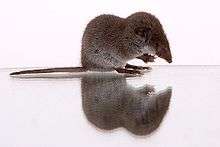
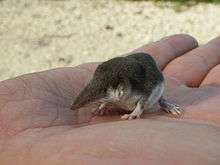
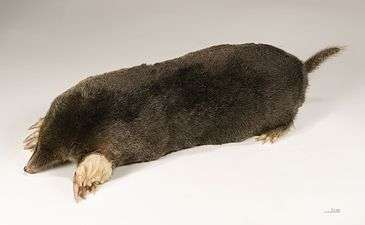
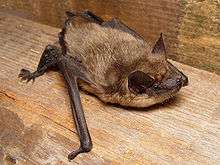
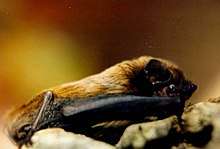
.jpg)
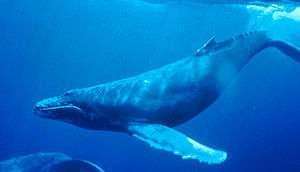
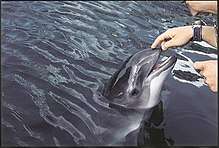
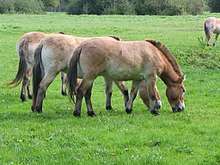
.jpg)
